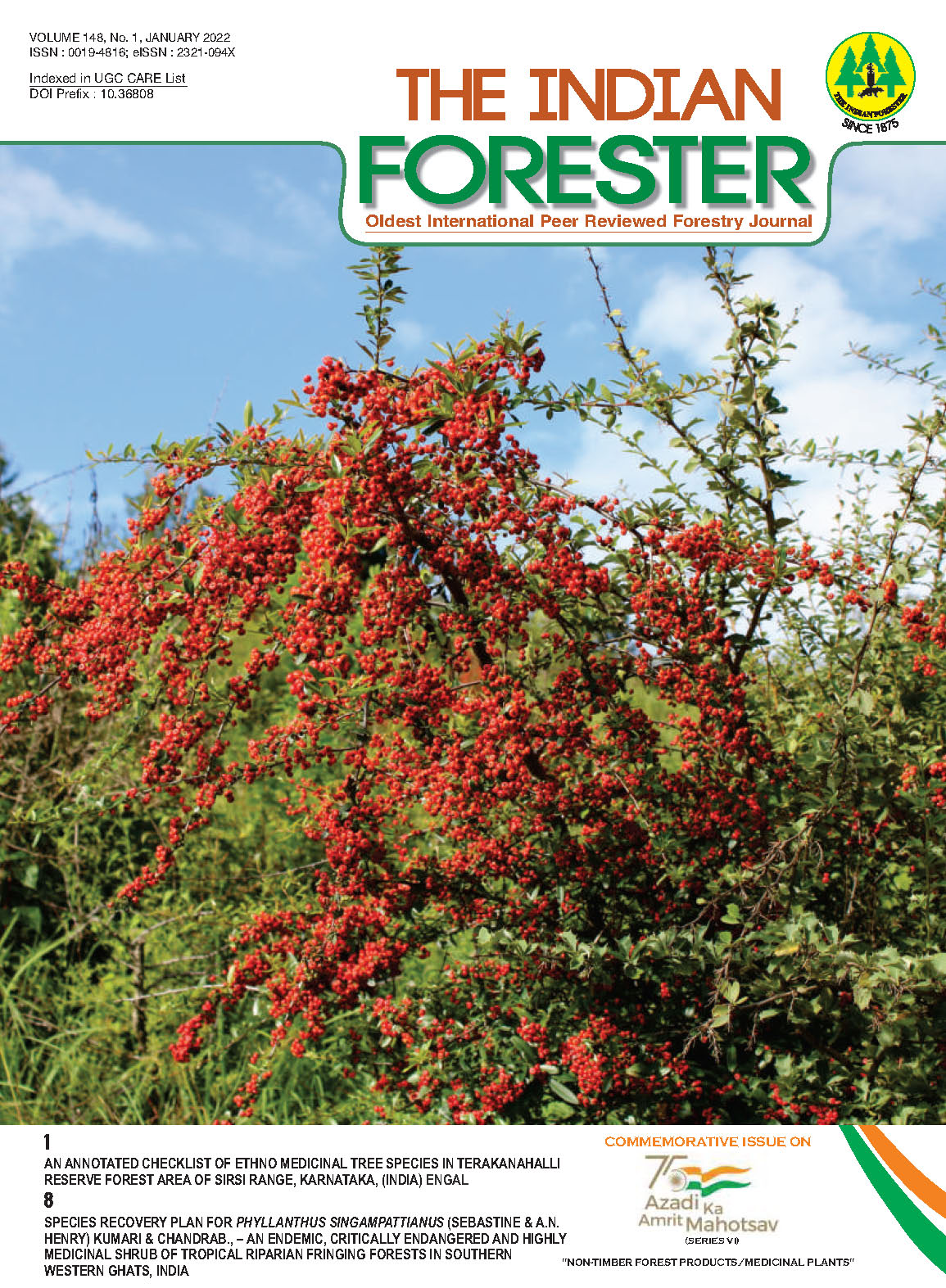Conservation Strategy for Endangered Medicinal Plant - Black Turmeric (Curcuma caesia)
DOI:
https://doi.org/10.36808/if/2022/v148i1/153548Keywords:
Black Turmeric, Conservation, Planting Material, Single Bud Rhizome, Endangered spp.Abstract
Black turmeric (Curcuma caesia Roxb.) is commonly known as kali haldi and it belongs to the family Zingiberaceae. The plant has a characteristic rhizome flesh of bluish-black colour with pungent smell and hot bitter taste. The crop is gaining popularity in nowadays due to its anticancerous property and short supply from the traditional forest areas. It is widely used as an important medicine to cure cancer in Chinese medicine. Its availability in forest area has continuously declined and the species needs to be restoring in non-conventional forest areas especially on farmer's field. It is propagated through rhizomes and large quantity of rhizome is required because of its poor vegetative propagation efficiency. Rhizomes are susceptible to diseases that cause tissue senescence and degeneration during storage and cultivation. It is difficult to propagate through seed because of poor flowering and inability to seed set. The planting material is not chiefly available for commercial cultivation. To overcome this problem, planting material produced from single bud rhizome of black turmeric under shade net condition will be planted instead of rhizomes. The main objective of this paper is to standardize the growing media for mass multiplication of black turmeric. Among the various treatments, rhizome with single bud planted in a growing media of cocopeat + vermicompost + Pseudomonas flouorescence give better crop establishment (95.99 per cent). Hence, rapid multiplication of black turmeric through single bud rhizome has been considered as the conservation strategy for this endangered medicinal plant.References
Durner E.F., Poling E.B. and Maas J.L. (2002). Recent advances in strawberry plug transplant technology. Horticulture Technology, 12: 545-550.
Erdogan O. and Benlioglu K. (2010). Biological control of Verticillium wilt on cotton by the use of fluorescent Pseudomonas spp. under field conditions. Biological Control, 53: 39-45.
Falahian F.Oraghi Ardebili Z. and Fahimi H. (2007). Effect of mycorrhizal fungi on some defence enzymes against Gaeumannomy cesgraminis in Wheat. Pakistan Journal of Biological Science, 10: 2257-2266.
Hammer Schmidt R. (1999). Induced disease resistance: how do induced plants stop pathogens. Physiology and Molecular Biology of Plants, 55: 77-84.
Hochmuth G., Chandler C., Stanley C., Legard D., Duval J., Waldo E., Cantliffe D. and Bish E. (2001). Containerized transplants for establishing strawberry crops in Florida. Horticultural Science, 37: 443-446.
Kumar S., Singh J., Shah N.C. and Ranjan V. (1998). Indian Medicinal Plants Facing Genetic Erosion. CIMAP, Lucknow, Pg. 219.
Mohammadi M. and Kazemi H. (2002). Changes in peroxidase and polyphenoloxidase activities in susceptible and resistant Wheat heads inoculated with Fusarium graminearum and induced resistance. Plant Science, 162: 491-498.
Pandey A.K. and Chowdhary A.R. (2003). Volatile constituents of rhizome oil of Curcuma caesia. Flavour and Fragrance Journal, 18: 463-465.
Panse V.G. and Sukatme P.V. (1957). Statistical methods for Agricultural Workers. Second Edition. pp. 152-157.
Pozo M.J., Azcon Aguilar C., Dumas Gaudot E. and Barea J.M. (1999). B-1, 3-glucanase activities in tomato roots inoculated with arbuscular mycorrhizal fungi and or Phytophthora parasitica and their possible involvement in bio-protection. Plant Science, 141: 149-157.
Pozo M.J., Cordier G., Dumas Gaudot E., Gianinazzi S., Barea J.M. and Azcon Aguilar G. (2002). Localized versus systemic effect of arbuscular mycorrhizal fungi on defence responses to Phytophthora infection in tomato plant. Journal of Experiment Botany, 53: 525-534.
Pozo M.J., Dumas Gaudot E., Azcon Aguilar C. and Barea J.M. (1998). Chitosanase and chitinase activities in tomato roots during interactions with arbuscular mycorrhizal fungi or Phytophthora parasitica. Journal of Experiment Botany, 49: 1729-1739.
Pozo M.J., Dumas Gaudot E., Slezack S., Cordier C., Asselin A., Gianinazzi S., Gianinazzi Pearson V., Azcon Aguilar C. and Barea J.M. (1996). Detection of new chitinase isoforms in arbuscular mycorrhizal tomato roots: possible implications in protection against Phytophthora nicotiana var. parasitica. Agronomie, 16: 689-697.
Ramamoorthy V., Raguchander T. and Samiyappan R. (2002). Induction of defence-related proteins in tomato roots treated with Pseudomonas fluorescens Pf1 and Fusarium oxysporum f. sp. Lycopersici. Plant, Soil and Environment, 239: 55-68.
Robert H. Stamps. (2009). Use of colored shade netting in horticulture. Hortscience, 44: 239-241.
Srivastava, R., Khalid, A., Singh, U.S. and Sharma, A.K., 2010. Evaluation of arbuscular mycorrhizal fungus, Pseudomonas fluorescenes and Terichoderma harzianum formulation against Fusarium oxysporum f. sp. lycopersici for the management of tomato wilt. Biology Control, 53(1): 24-31.
Takeda F. and Hokanson S.C. (2003). Strawberry fruit and plug plant production in the greenhouse. Acta Horticulturea, 626: 283-285.
Thangavelu R., Palaniswami A., Doraiswamy S. and Velazhahan R. (2003). The effect of Pseudomonas fluorescens and Fusariumoxysporum f. sp. Cubense on induction of defence enzymes and phenolics in banana. Biologia Plantarum, 46: 107-112.
Vázquez M.M., César S., Azcón R. and Barea J.M. (2000). Interactions between arbuscularmycorrhizal fungi and other microbial inoculants (Azospirillum, Pseudomonas, Trichoderma) and their effects on microbial population and enzyme activities in the rhizosphere of maize plants. Applied Soil Ecology, 15: 261-272.
Downloads
Downloads
Published
How to Cite
Issue
Section
License
Unless otherwise stated, copyright or similar rights in all materials presented on the site, including graphical images, are owned by Indian Forester.





